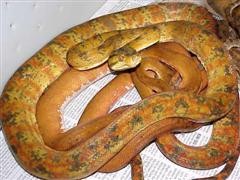Boa - Amazon Tree
Cutri Boa Scientific Name: Corallus enydris enydris
Mon, 14th July, 2025 - 9:43 pm GMT
Sponsor Ads:

Alternative Name
Cutri Boa Scientific Name: Corallus enydris enydrisBasic Info
The Amazon Tree Boa is one of the most colorful and beautiful species of snake. These creatures make wonderful display animals. Their moderate size and unique coloration make them great for Corallus keepers. Amazon Tree Boas have varied color patterns. No Amazon Tree Boa looks like another. It is a small boa, reaching only a few feet in size at maturity.
Health
The Amazon Tree Boa can be quite difficult to feed in captivity because many refuse rodents, prefering small frogs and lizards. These snakes should be switched to small rodents as soon as possible to avoid spread of parasites and disease from the frogs or lizards to the snake. Amazon Tree Boas should be kept in temperatures ranging form 82 to 70 degrees between day and night, respectively. A hot spot for basking (about 90 degrees Fahrenheit) is necessary, and should be left on all the time. High humidity is very important for the Amazon Tree Boa, and it should fluctuate between 70% and 90%. The air in the habitat should circulate to prevent mold and fungus from growing. A timed misting system is highly recommended. Breeding Baby Amazon Tree Boas should be separated from each other and the parents, due to cannibalistic occurrences. Babies should be fed every five to seven days.Habitat
Live and plastic plants can be used in the Amazon Tree Boa's habitat.Behavior
The Amazon Tree Boa is renowned for its disposition and temperament. In fact, this species is often overlooked due to its nasty behavior. They are very snappy, and will bite, with sharp teeth, if they can. Great care must be taken when handling these snakes. They can move extremely fast when they want to. Unless breeding, it is best not to keep two of these snakes in the same cage, as they may end up killing each other over food. If a baby Tree Boa is raised in captivity with lots of human interaction, it can become a more tolerant snake that will do well when handled. Many individuals in the pet trade are wild caught, and like all wild caught snakes they may be more likely to carry diseases. Amazon Tree Boas will spend much of their time in an inactive, coiled state at the bottom of their habitat. They should, however, have plenty of plants and branches for climbing. Their habitat should be roughly 20 gallons in volume, and should lean towards a tall and narrow tank. A large water bowl for drinking and soaking should be present as well. Their cage should also have a wide space to work in. When working in the cage, there should be as much room between you and the snake as possible to avoid bites.The Amazon Tree Boa likes to rest on a bed of vegetation. Regardless of their temperament, the Amazon Tree Boa is highly desired for its vivid and beautiful coloration.Origin
South AmericaHistory
The Amazon Tree Boa is from the Amazon basin in South America.Common Foods
They will eat just about any animal of appropriate size including each other and other reptiles, fish, birds, rodents, pigs, and monkeys.Sponsor Ads:
Experience is not what happens to a man, it is what a man does with what happens to him. --Aldous Huxley
Boa - Amazon Tree
Coded by: BGID® | ALL RIGHTS RESERVED Copyright © 2000-2025
Disclaimer | Privacy | Report Errors / Contact | Credits
















